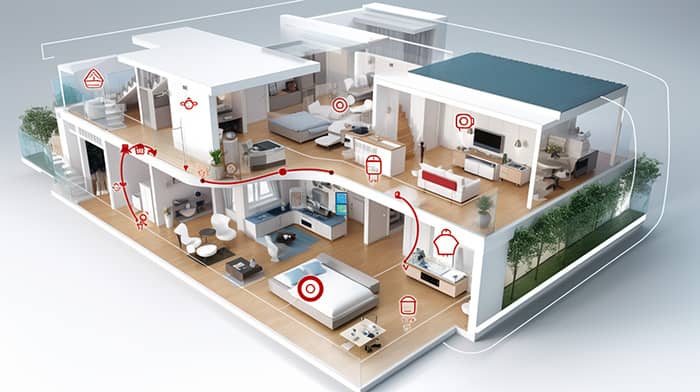Navigating the Landscape of Smart Home Wireless Technologies

The market boasts a plethora of wireless technologies, each with its unique characteristics. From the ubiquity of Wi-Fi to the efficiency of Zigbee and Z-Wave, the versatility of Bluetooth, and the promise of Thread, understanding these protocols is crucial for creating a connected and cohesive smart home ecosystem. This article will dissect these technologies, providing insights to help you navigate and make informed decisions about the wireless backbone of your smart home.
Wi-Fi

Wi-Fi, short for Wireless Fidelity, refers to a set of wireless communication technologies that enable devices to exchange data without the need for physical cables or wires. It allows devices like computers, smartphones, tablets, and other hardware to connect to the internet and local area networks (LANs) wirelessly.
Wi-Fi operates using radio frequency (RF) signals to transmit information between devices and a Wi-Fi router or access point. The router is connected to a wired network and acts as a gateway, allowing wireless devices to connect to the internet or other devices on the network. Wi-Fi has become a standard feature in homes, businesses, public spaces, and various other locations, providing a convenient and flexible way to access the internet and network resources without the constraints of wired connections.
From smart speakers like Amazon Echo to security cameras and smart thermostats, Wi-Fi’s versatility enables the connection of diverse devices under a unified network. Wi-Fi 6, the latest standard promising faster speeds, improved performance in crowded networks, and enhanced security features.
Zigbee

Zigbee is a wireless communication standard designed for short-range, low-power digital communication among devices. It is often used for smart home and industrial applications where low-power, low-data-rate, and low-cost communication are essential. Zigbee operates on the IEEE 802.15.4 standard, defining the physical (PHY) and medium access control (MAC) layers.
Key features of Zigbee include:
- Low Power Consumption: Zigbee devices are designed to operate on low power, making them suitable for battery-powered devices like sensors and actuators.
- Mesh Networking: Zigbee supports mesh networking, allowing devices to communicate with each other through multiple pathways. This can enhance the overall reliability and range of the network.
- Low Data Rate: Zigbee is designed for applications with relatively low data rate requirements. It is not meant for high-bandwidth applications but is well-suited for transmitting small amounts of data.
- Short Range: Zigbee operates in the 2.4 GHz frequency band (though there are regional variations), providing short to medium-range communication. The range is typically up to a few tens of meters.
- Interoperability: Zigbee Alliance, a group of companies that maintain and publish the Zigbee standard, works to ensure interoperability between different Zigbee devices, allowing products from different manufacturers to work together seamlessly.
- Applications: Zigbee is commonly used in home automation and smart home devices, industrial automation, healthcare, and other applications where low-power, short-range communication is essential.
Applications of Zigbee in the real world, from smart lighting systems and door/window sensors to connected thermostats. Recognize how Zigbee’s unique features contribute to the reliability and efficiency of these smart devices.
Z-Wave

Z-Wave is a wireless communication protocol used for home automation. It’s designed for controlling and automating various devices in a smart home environment, such as lights, thermostats, door locks, sensors, and more. Z-Wave operates on the sub-1 GHz band, which helps to avoid interference with other wireless technologies like Wi-Fi and Bluetooth.
Key features of Z-Wave include:
- Mesh Networking: Z-Wave devices form a mesh network, allowing them to communicate with each other and extend the range of the network. This can enhance the reliability and coverage of Z-Wave in a home.
- Low Power Consumption: Z-Wave devices are typically designed to be energy-efficient, which means they can operate on battery power for extended periods. This is important for devices like sensors that may be placed in locations without easy access to power.
- Interoperability: Z-Wave is a standardized protocol, which means that devices from different manufacturers that support Z-Wave should be able to work together seamlessly. This promotes interoperability and allows users to build a smart home system with devices from various vendors.
- Security: Z-Wave has security features built into its protocol to protect the communication between devices. This includes encryption to prevent unauthorized access.
- Easy Setup: Setting up a Z-Wave network is generally considered to be user-friendly. Most Z-Wave devices can be added to a network with a simple pairing process.
From smart door locks and sensors to smart plugs and lighting controls, Z-Wave’s compatibility and reliability make it a preferred choice for various smart home scenarios.
Bluetooth

Bluetooth is a wireless technology standard used for exchanging data between devices over short distances. It operates in the 2.4 GHz frequency range and is a common method for connecting and transferring data between devices like smartphones, tablets, laptops, headphones, printers, and various other electronic devices.
Bluetooth technology allows for secure and reliable communication between devices without the need for physical cables. It’s commonly used for tasks such as transferring files, connecting peripherals like keyboards and mice, streaming audio to speakers or headphones, and establishing wireless connections between devices for tasks like file sharing or internet tethering.
Bluetooth devices typically need to be paired before they can communicate with each other. Once paired, devices can establish a connection automatically when they are in range, making it a convenient and widely adopted wireless technology for personal area networking.
Thread

A “thread” typically refers to a wireless networking protocol designed for connecting smart devices within the home. Thread is a low-power, wireless mesh networking protocol that enables communication between various smart devices such as smart thermostats, light bulbs, door locks, and other Internet of Things (IoT) devices.
Thread is designed to provide reliable and secure communication between devices while maintaining low power consumption. It operates on standard IEEE 802.15.4 radio frequency and supports IPv6 networking, allowing devices to communicate with each other and with the broader internet. The mesh networking aspect of Thread is particularly important in smart homes because it allows devices to communicate with each other even if they are not directly within range, as signals can hop through other devices in the network.
One notable feature of Thread is its ability to create a self-healing network. If one device in the mesh network fails or goes offline, the other devices can find alternative paths for communication, ensuring that the overall network remains operational. Thread is often considered as a reliable and scalable solution for smart home automation, and it is supported by industry groups such as the Thread Group, which promotes its adoption and development.
Comparison and Considerations

When analyzing Wi-Fi, Zigbee, Z-Wave, Bluetooth, and Thread as wireless technologies for smart homes, several key factors come into play. Wi-Fi is known for its high data transfer rates and widespread compatibility, making it suitable for bandwidth-intensive applications. Zigbee and Z-Wave, on the other hand, excel in low-power, low-data-rate scenarios, making them ideal for devices like sensors and actuators in smart homes.
Bluetooth offers a good balance between data rate and power consumption, making it versatile for various applications. Thread, designed on the IEEE 802.15.4 standard, focuses on reliable, low-power mesh networking. When choosing a smart home wireless technology, consider factors such as range, data rate, power consumption, interoperability, and security.
Each technology has its strengths and weaknesses, so the choice depends on the specific requirements of your smart home application.
| Factor | Wi-Fi | Zigbee | Z-Wave | Bluetooth | Thread |
|---|---|---|---|---|---|
| Data Rate | High | Low to Medium | Low | Medium | Low |
| Range | Long | Short to Medium | Short to Medium | Short | Medium |
| Power Consumption | High | Low | Low | Medium | Low |
| Interoperability | High | Medium | Medium | High | Medium |
| Security | High | Medium | High | High | High |
Consider these factors carefully to choose the wireless technology that best aligns with the specific needs and constraints of your smart home setup.
Future Trends of Wireless Technologies

Emerging technologies in the smart home wireless space have ushered in a new era of convenience, efficiency, and connectivity. As the Internet of Things (IoT) continues to evolve, smart home devices are becoming increasingly sophisticated, offering seamless integration and communication. Advanced wireless protocols such as Zigbee, Z-Wave, and Bluetooth Low Energy (BLE) are enabling devices to communicate efficiently with each other, forming a cohesive and interconnected ecosystem.
Moreover, the rise of voice-activated assistants like Amazon’s Alexa and Google Assistant has further streamlined user interaction with smart devices, making it more intuitive and accessible. The integration of artificial intelligence and machine learning algorithms enhances the adaptability and responsiveness of smart home systems, learning from user behavior to anticipate preferences and optimize energy usage. With ongoing advancements, the smart home wireless landscape is poised to continue expanding, offering users unprecedented control and automation over their living spaces.
The advent of 5G technology is poised to revolutionize smart home connectivity, significantly impacting the way devices communicate and function within the home environment. With its remarkable speed, low latency, and high capacity, 5G provides a robust foundation for a more interconnected and responsive smart home ecosystem. The enhanced network capabilities of 5G enable faster data transfer, allowing smart devices to communicate in real-time and respond swiftly to user commands.
This low-latency connectivity is particularly crucial for applications like smart security systems, where immediate response times are imperative. Additionally, the increased network capacity of 5G can accommodate the growing number of connected devices in a smart home, preventing network congestion and ensuring a seamless user experience. As 5G deployment continues to expand, the smart home is poised to benefit from enhanced connectivity, unlocking new possibilities for automation, entertainment, and overall home management.
Security and Privacy

The proliferation of smart home devices has ushered in unprecedented convenience and connectivity, but it has also given rise to a host of security concerns. As these devices become integral parts of our daily lives, they often collect sensitive data and are susceptible to cyber threats. Security vulnerabilities in smart home devices can expose users to privacy breaches, unauthorized access, and even compromise the overall safety of the home environment.
Common concerns include weak authentication mechanisms, inadequate encryption, and the potential for device hijacking. To address these issues, various wireless technologies employed in smart home ecosystems have implemented measures to enhance security. Zigbee, for instance, employs AES-128 encryption to secure communication between devices.
Wi-Fi networks leverage WPA3 encryption protocols, providing robust protection against unauthorized access. Additionally, Bluetooth Low Energy (BLE) devices often incorporate features like secure pairing and encryption to safeguard data transmissions. These security measures are crucial in fortifying smart homes against the evolving landscape of cyber threats, ensuring that users can enjoy the benefits of automation and connectivity without compromising their privacy and safety.
- Best Amazon Smart Home Devices - December 26, 2023
- Alloy Smart Home Thermostat - December 10, 2023
- The Rising Trend of Smart Windows - November 27, 2023




